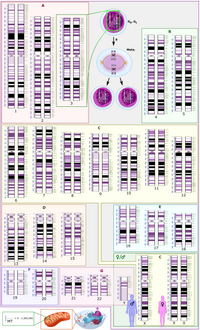
Photo from wikipedia
Corneal dystrophies (CDs) represent a group of inherited diseases characterized by the progressive deposit of abnormal materials in the cornea. This study aimed to describe the variant landscape of 15… Click to show full abstract
Corneal dystrophies (CDs) represent a group of inherited diseases characterized by the progressive deposit of abnormal materials in the cornea. This study aimed to describe the variant landscape of 15 genes responsible for CDs based on a cohort of Chinese families and a comparative analysis of literature reports. Families with CDs were recruited from our eye clinic. Their genomic DNA was analyzed using exome sequencing. The detected variants were filtered using multi-step bioinformatics and confirmed using Sanger sequencing. Previously reported variants in the literature were summarized and evaluated based on the gnomAD database and in-house exome data. In 30 of 37 families with CDs, 17 pathogenic or likely pathogenic variants were detected in 4 of the 15 genes, including TGFBI, CHST6, SLC4A11, and ZEB1. A comparative analysis of large datasets revealed that 12 of the 586 reported variants are unlikely causative of CDs in monogenic mode, accounting for 61 of 2933 families in the literature. Of the 15 genes, the gene most frequently implicated in CDs was TGFBI (1823/2902, 62.82% of families), followed by CHST6 (483/2902, 16.64%) and SLC4A11 (201/2902, 6.93%). This study presents, for the first time, the landscape of pathogenic and likely pathogenic variants in the 15 genes responsible for CDs. Awareness of frequently misinterpreted variants, such as c.1501C>A, p.(Pro501Thr) in TGFBI, is crucial in the era of genomic medicine.
Journal Title: International Journal of Molecular Sciences
Year Published: 2023
Link to full text (if available)
Share on Social Media: Sign Up to like & get
recommendations!